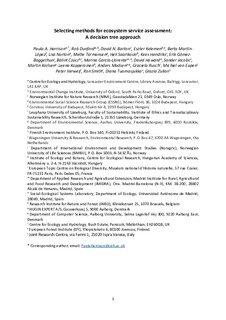| dc.contributor.author | Harrison, Paula A. | |
| dc.contributor.author | Dunford, Robert | |
| dc.contributor.author | Barton, David Nicholas | |
| dc.contributor.author | Kelemen, Eszter | |
| dc.contributor.author | Martín-López, Berta | |
| dc.contributor.author | Norton, Lisa | |
| dc.contributor.author | Termansen, Mette | |
| dc.contributor.author | Saarikoski, Heli | |
| dc.contributor.author | Hendriks, Kees | |
| dc.contributor.author | Gomez-Baggethun, Erik | |
| dc.contributor.author | Czúcz, Balint | |
| dc.contributor.author | García-Llorente, Marina | |
| dc.contributor.author | Howard, David | |
| dc.contributor.author | Jacobs, Sander | |
| dc.contributor.author | Karlsen, Martin | |
| dc.contributor.author | Kopperoinen, Leena | |
| dc.contributor.author | Madsen, Andes | |
| dc.contributor.author | Rusch, Graciela | |
| dc.contributor.author | van Eupen, Michiel | |
| dc.contributor.author | Verweij, Peter | |
| dc.contributor.author | Smith, Ron | |
| dc.contributor.author | Tuomasjukka, Diana | |
| dc.contributor.author | Zulian, Grazia | |
| dc.date.accessioned | 2017-11-13T12:20:45Z | |
| dc.date.available | 2017-11-13T12:20:45Z | |
| dc.date.created | 2017-11-02T13:06:19Z | |
| dc.date.issued | 2017 | |
| dc.identifier.issn | 2212-0416 | |
| dc.identifier.uri | http://hdl.handle.net/11250/2465812 | |
| dc.description.abstract | A range of methods are available for assessing ecosystem services. Methods differ in their aims; from mapping and modelling the supply and demand of ecosystem services to appraising their economic and non-economic importance through valuation techniques. Comprehensive guidance for the selection of appropriate ecosystem service assessment methods that addresse the requirements of different decision-making contexts is lacking. This paper tackles this gap using the experience from 27 case studies which applied different biophysical, socio-cultural and monetary valuation methods to operationalise the ecosystem service concept towards sustainable land, water and urban management. A survey of the reasons why the case study teams selected particular methods revealed that stakeholder-oriented reasons, such as stakeholder participation, inclusion of local knowledge and ease of communication, and decision-oriented reasons, such as the purpose of the case study and the ecosystem services at stake, were key considerations in selecting a method. Pragmatic reasons such as available data, resources and expertise were also important factors. This information was used to develop a set of linked decision trees, which aim to provide guidance to researchers and practitioners in choosing ecosystem service assessment methods that are suitable for their context. | nb_NO |
| dc.language.iso | eng | nb_NO |
| dc.rights | Attribution-NonCommercial-NoDerivatives 4.0 Internasjonal | * |
| dc.rights.uri | http://creativecommons.org/licenses/by-nc-nd/4.0/deed.no | * |
| dc.title | Selecting methods for ecosystem service assessment: A decision tree approach | nb_NO |
| dc.type | Journal article | nb_NO |
| dc.type | Peer reviewed | nb_NO |
| dc.description.version | acceptedVersion | nb_NO |
| dc.subject.nsi | VDP::Matematikk og Naturvitenskap: 400::Zoologiske og botaniske fag: 480 | nb_NO |
| dc.source.journal | Ecosystem Services | nb_NO |
| dc.identifier.doi | 10.1016/j.ecoser.2017.09.016 | |
| dc.identifier.cristin | 1510301 | |
| cristin.unitcode | 7511,6,0,0 | |
| cristin.unitcode | 7511,2,0,0 | |
| cristin.unitname | Oslo | |
| cristin.unitname | Avdeling for terrestrisk økologi | |
| cristin.ispublished | true | |
| cristin.fulltext | postprint | |
| cristin.qualitycode | 1 | |

